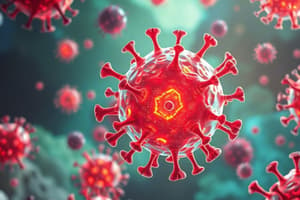Podcast
Questions and Answers
What occurs during the protein synthesis of a virus?
What occurs during the protein synthesis of a virus?
- Capsid proteins are decomposed
- Endoplasmic reticulum generates new cells
- Viral RNA genomes are assembled into viral RNA (correct)
- Viral RNA genomes are destroyed
How are mature nucleocapsids formed in viruses?
How are mature nucleocapsids formed in viruses?
- Through the plasma membrane
- Via nuclear fusion
- By the breakdown of host DNA
- Through the endoplasmic reticulum membrane (correct)
Which of the following best describes the transmission of Dengue virus?
Which of the following best describes the transmission of Dengue virus?
- Contact with contaminated surfaces
- Direct contact with infected blood
- Transmission through infected mosquitoes (correct)
- Inhalation of airborne particles
What happens during the viremia phase of Dengue virus infection?
What happens during the viremia phase of Dengue virus infection?
What type of genetic material do adenoviruses have?
What type of genetic material do adenoviruses have?
What is the function of hexon proteins in adenoviruses?
What is the function of hexon proteins in adenoviruses?
Flashcards are hidden until you start studying
Study Notes
Protein Synthesis
- Newly synthesized viral RNA genomes are assembled into viral RNA, including structural proteins.
Assembly
- Viral genomes and capsid proteins assemble together into mature nucleocapsids through the endoplasmic reticulum (ER) membrane.
- Host cell acquires envelope by exocytosis.
Pathogenesis of Dengue Virus
- Dengue virus is primarily transmitted to humans through the bite of infected mosquitoes.
- Virus enters the body and targets immature cells.
- Viremia occurs, where the virus circulates in the bloodstream, usually within 4-10 days after infection.
- Dengue symptoms include widespread infection, high fever, severe headache, eye pain, joint muscle pain, rash, and mild bleeding.
Adenovirus
- Adenoviruses are medium-sized (90-100 nm), non-enveloped viruses with double-stranded DNA.
- There are more than 50 types of distinct adenoviruses that can cause infections in humans.
- The capsid is composed of protein subunits called capsomeres.
- Hexon proteins are the most distinct adenovirus proteins.
Adenovirus Replication
- Attachment: Adenovirus attaches to specific receptors on a host cell.
- Entry: The virus gets engulfed by the host cell into an endosome.
- Genome: The genome is likely encoded by more than 50 distinct adenoviruses.
Studying That Suits You
Use AI to generate personalized quizzes and flashcards to suit your learning preferences.




